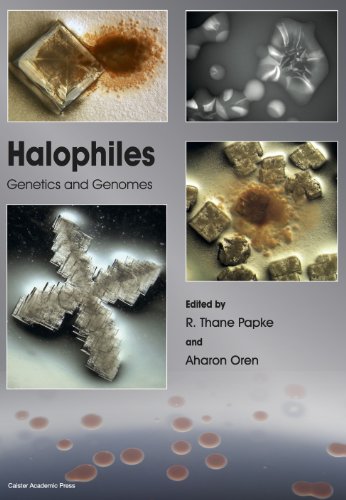Halophiles: Genetics and Genomes 2014
دانلود کتاب پزشکی هالوفیل ها: ژنتیک و ژنوم
| نویسنده |
Aharon Oren, R. Thane Papke |
|---|
| تعداد صفحهها |
196 |
|---|---|
| نوع فایل |
|
| حجم |
9 Mb |
| سال انتشار |
2014 |
89,000 تومان
محیط های پر شور، از جمله دریاچه های نمک، چشمه ها، تأسیسات تبخیر آب دریا برای تولید نمک دریا، و ذخایر نمک باستانی مشتق شده از اقیانوس ها، به طور پراکنده در سراسر زمین پخش شده اند. زندگی تحت سلطه میکروب ها، به عنوان مثال، پروکاریوت ها و ویروس هایی که آنها را آلوده می کنند. بهترین مورد مطالعه در این محیط ها Haloarchaea (خانواده Halobacteriaceae)، گروه متنوعی از موجودات نمک دوست در خانواده باستانی Euryarchaeota است. این موجودات شگفت انگیز برای زنده ماندن نیازهای اجباری غلظت نمک بین 10 تا 35 درصد نمک طعام دارند (آب دریا 3.5 درصد نمک دارد). Halorchaea چندین استراتژی بیوشیمیایی و مولکولی را برای مقابله با اثرات نامطلوب محیطهای نمکی خود از جمله پمپهای یونی کارآمد، رنگدانههای جذب کننده UV و پروتئینهایی که میتوانند در برابر اثرات استرس اسمزی و اثرات نمکهای دناتورهکننده مقاومت کنند، تکامل دادهاند. سالینی باکتر یکی از بهترین هالوفیل های مطالعه شده است که در حوضچه های تبلور آب شور در سراسر جهان فراوان است. استفاده از روشهای مدرن ژنومی برای تحقیقات روی باستانها، باکتریهای هالوفیل و ویروسهای آنها در سالهای اخیر، بینشهای شگفتانگیزی را در مورد سازگاری و تکامل این موجودات منحصربهفرد به دست آورده است. این کتاب تحقیقات کنونی ژنومیک و ژنتیک را برای ارائه یک نمای کلی به موقع برجسته می کند. فصول توسط نویسندگان متخصص از سراسر جهان نوشته شده است و شامل موضوعاتی مانند: اکولوژی و تکامل Haloquadratum walsbyi; تنوع بخشی لاستیک آب نمک؛ انتقال افقی ژن در هالوباکتری ها ژنومیک مقایسه ای هالوویروس ها. ژنومیک باکتری های هالوفیل Natranaerobius thermophilus و Halobacillus halophilus. دیواره سلولی توهم زا؛ چرخه سلولی و پلی پلوئیدی در هالوارکیا. سازماندهی سلول ها توسط سیستم های گلیکولیتیک و کونژوگاسیون پروتئین. این کار جدید، منبع ارزشمندی از اطلاعات برای همه دانشمندان علاقه مند به میکروارگانیسم های هالوفیل، اکسترموفیل ها، اکولوژی میکروبی و میکروبیولوژی محیطی است.
Extreme halophilic environments, including salt lakes and springs, seawater evaporation facilities for the production of sea salt, and subterranean salt deposits derived from ancient oceans are distributed patchily all over the earth. The life that dominates them is microbial e.g., prokaryotes and the viruses that infect them. The best studied in these environments are the haloarchaea (family Halobacteriaceae), a diverse group of salt-loving organisms in the archaeal phylum Euryarchaeota. These remarkable organisms have an obligate requirement for salt concentrations between 10% and 35% NaCl for survival (sea water has 3.5% salt). Haloarchaea have evolved several biochemical and molecular strategies to counteract the deleterious effects of their salty environments including efficient ion pumps, UV absorbing pigments, proteins that can resistant the effects of osmotic stress and the denaturing effects of salts. The best studied extremely halophilic member of the Bacteria is Salinibacter, which is abundant in saltern crystallizer ponds worldwide. The application of modern genomic approaches to research on halophilic Archaea and Bacteria and their viruses in recent years has yielded fascinating insights into the adaptations and evolution of these unique organisms. This book highlights current genetics and genomics research to provide a timely overview. Chapters are written by expert authors from around the world and include topics such as: ecology and evolution of Haloquadratum walsbyi; microdiversity of Salinibacter ruber; horizontal gene transfer in halobacteria; comparative genomics of haloarchaeal viruses; genomics of the halophilic bacteria Natranaerobius thermophilus and Halobacillus halophilus; the haloarchaeal cell wall; cell cycle and polyploidy in haloarchaea; cell regulation by proteolytic systems and protein conjugation. This major new work represents a valuable source of information to all those scientists interested in halophilic microorganisms, extremophiles, microbial ecology and environmental microbiology.




